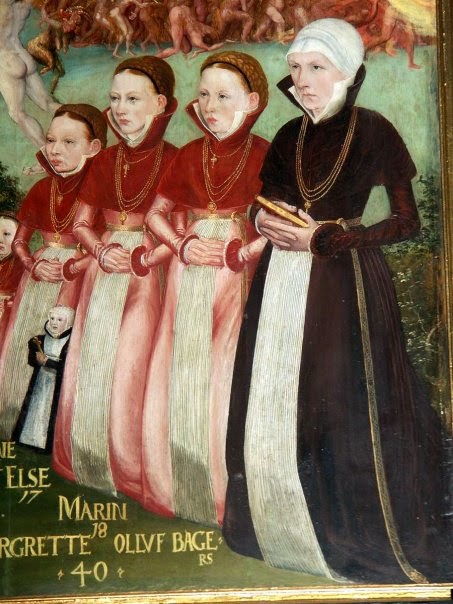A Danish painting from 1575, showing a gollar:
Detta är förmodligen vad som i svenska samtida dokument kallas "kraga". Tidigare bilder visar dem med lägre krage och eftersom min svenska 1500-talsdräkt siktar lite på 1560-talet valde jag att göra en mindre krage på min också. Däremot behöll jag längden, så att den går ner ordentligt på axlarna.
Materialet är tjockt valkat ylle fodrat med tunt rött siden. Den hålls ihop av hyskor och hakar och jag har dekorerat den med fingerpåtad snodd gjord av ullgarn.
My gollar. Made from wool cloth, lined with red silk and decorated with a lucet cord from wool yarn. It is closed with hooks and eyes.
Som framgår orkade jag inte gräva fram min blå klänning och ta på mig den utan min provdocka "Ståtliga Sofi" (uppkallad efter en roman av Georgette Heyer) fick på sig en 1500-talssärk, som jag verkligen behöver forma om kråset på, och sen "kragen".
Inspirationen till dekoren kom från den här målningen från 1500-talets Tyskland:
The inspiration for the decoration came from this 16th century German painting:
This was a challenge that was really hard for me to come up with something for. You may have noticed that I'm not a great fan of black and since I had made a shift in another challenge I didn't feel like repeating myself. I have also run out of the linen thread that I use for hand sewing shifts. Then there's the fact that I came home from England on Saturday and that I was extremely busy both before and after that. The for example ruled out the obvious solution, which was blackwork.
But yesterday I came up with the idea to make a gollar, the shoulder cape worn in so many German portraits from the 16th century. You find them in Scnadinavia too, as can be seen on the top image, which comes from the fantastic site livinghistory.dk, which has tons of pictures of grave monuments and paintings from mainly Danish, but also Swedish and Norwegian churches.
This garment is probably what was meant by the term "kraga", which is found in swedish 16th century documents and could be made of wool or silk. Earlier images than that one shows gollars with lower collars, and since my Swedish 16th century dress aims for the 1560s I decided to make my collar lower too. I did keep the length though, so it goes down a fair bit.
As you can see I didn't have the energy to dig up my blue dress and put it on, so my dress dummy "The Grand Sophy" (named after a novel by Georgette Heyer) got a smock on, on which I really have to starch and set the ruffle, and then the gollar.
The Challenge: #9 Black and white
Fabric: Wool for the outer layer, silk for lining
Notions: Lucet cord from wool yarn, hooks and eyes
Pattern: Self-drafted
Year: 1550-1560
How historically accurate is it? It is partly machine sewn
with polyester thread and the hooks and eyes are modern, though the difference from
period ones aren’t that big
Hours to complete: 5 maybe
First worn: It will be worn on the SCA event Double
Wars at the end of May
Total cost: The wool was a gift from my mother a decade
ago, the silk was maybe 6 dollars, the cord less than a dollar and the hooks
and eyes probably 4 dollars.





Inga kommentarer:
Skicka en kommentar